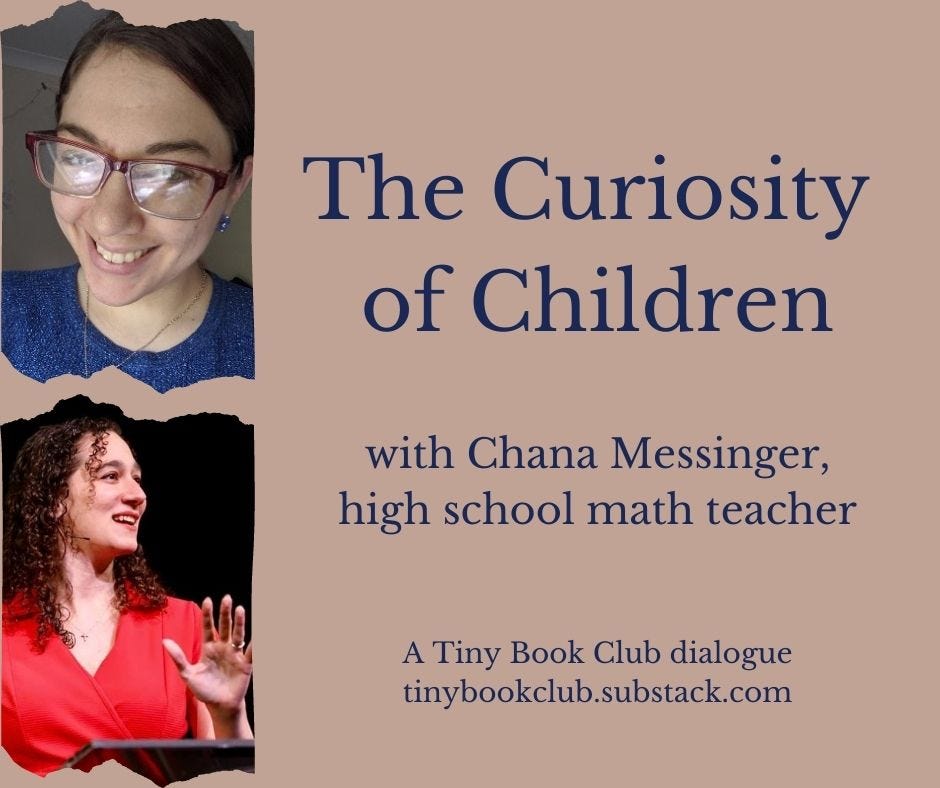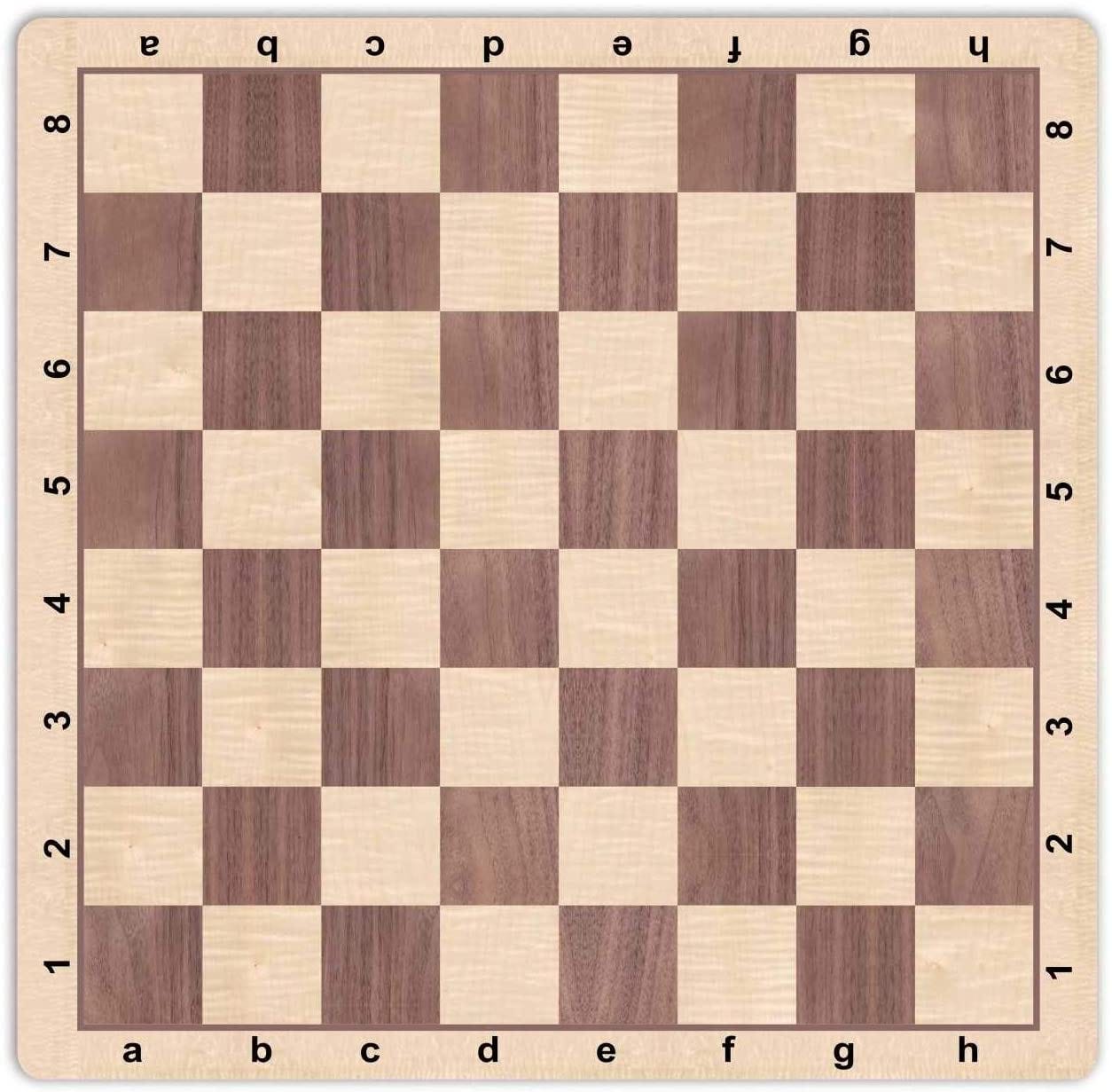In the first part of our conversation, Chana and talked about our own strong senses of curiosity, and whether we still have the hungry need to know of a child. In the second part of our dialogue, we’re talking about how we invite others into curiosity in our work as teachers.

Leah: In our first discussion, we talked about our own experiences of curiosity. As a teacher, how do you invite students into these moments of uncertainty and a positive, yearning curiosity? I’ve taught math, too, and my students’ first instinct when they hit something they didn’t know was often to freeze and play dead, waiting for me to save them. How do you help your students believe that ignorance might be an opportunity, or even a chance for playfulness?
Chana: This is a central element (and challenge) of teaching! I therefore have a tremendous amount to say about it.
It starts with the first day of class in the ninth grade, where I give students a chessboard and ask them how many squares are on it, and give them time in groups to discuss it.

(Leah: You’re all welcome to take a crack at it, newsletter folks! I did.)
(Back to Chana:) It’s an amazing first day problem; it starts out obvious, then its nonobviousness becomes apparent. Students can access the answer through drawing and counting, or through seeing a pattern in the number of squares of different sizes. It’s a way of right away communicating that this math class is going to be about questions and conversation. I hope it also gives them the sense that mathematical puzzles are found outside of textbooks.
At my current school, I then have them flip over the paper, and on the reverse side is a list of habits of mind which includes:
is eager to explore
persists in the face of challenges
takes risks
has an open and flexible mind
Sees how being wrong can be good (this one I have trouble really selling, if I’m honest)
And I ask which they feel they exhibited in that conversation.
Leah: I love this! I think it’s particularly good that you put them in a position to live out some of these virtues, and then notice them, rather than handing them out as instructions or aspirations. In part, I think it’s hard to learn these virtues in the classroom because there’s often very little time to explore and play. And seldom do students have the experience of being wrong being good.
One thing I did in my own classroom was to give quizzes during the class, on what we’d just learned. But I didn’t collect them when time was up—the students could keep working on them all through class, and ask questions to clarify something they got stuck on. I wanted them to have the moment of panic I knew they had while doing homework in the classroom instead (that “Oh man I thought I understood this when I was taking notes, but not now that I’m doing it!” feeling). And then, they’d have time to recover and to experience that panic or blankness leading to learning, not just a miserable night.
How did you get students to practice these virtues in the classroom?
Chana: We talk about those habits of mind all year, so one answer to your question is that I talk about it explicitly. I talk about “sitting with uncertainty” and learning to be less uncomfortable with it. When students ask a question that is “is this the right approach” in disguise, I’ll tell them that I’m here to help if they’re stuck with no ideas. If they have an idea, they should see if it works.
Another layer is how I respond in the moment to their uncertainty. Much like young children who hurt themselves and look to their parents to see how bad it is, my students take some cues from me on how deep the pit they’re in is. I have a number of commonly used lines and approaches, garnished from many sources or developed myself. There are many in the realm of reducing the pain of uncertainty and encouraging mistake-making, but I’ll focus on the ones that are most relevant to curiosity:
Cultivating an excellent poker face for when students suggest an answer, leaving time and space for other students to chime in, sometimes prompted by “agree or disagree”. When students disagree, I get really excited, since it makes them want to know who’s right and lights a fire under them to figure it out. If needed, I’ll suggest a test for finding out. (I imagine my excitement helps incentivize disagreement, too).
Polling students for their guesses of what they think the answer is, in advance of solving it. Helps develop intuition, and also sparks debates and that drive to want to know who’s right.
Modelling curiosity. If I don’t know an answer, I’ll say so, and ask the student if they want to find out with me, and we’ll do some problems together to look for the pattern. I’ll often follow that up by sending along related links I find.
The best way is probably to have good questions in the first place. Math teacher blogger celebrity Dan Meyer beats a constant drum for questions that, whether “real world” or not, are perplexing, the kind of questions that grab you and make you want to know the answer. The link I provided gives many examples. I like the chessboard problem for this, as well as noticing that adding increasing numbers of consecutive odd numbers (starting at one) has a peculiar pattern. Applying the pythagorean theorem to other shapes is also great. This approach asks me to stop trying to channel the flow of my students’ natural curiosity in the convenient directions, and ask what is actually interesting. What would I find interesting if I didn’t already know the answer? What do I find interesting even though I do know the answer?
I’m also constantly modelling curiosity about them. That’s no stratagem, I just am really curious about what is going on in their minds and how sensemaking is happening in front of me. I ask them about their thinking and try to figure out exactly what they do and don’t understand. I’m excited by interesting mistakes and what thought process goes into them.
Finally, I get very excited and appreciative of their curiosity, or any of the building blocks for it. It’s the vibe I set, and it’s how I incentivize more of it. A student has another way of doing a problem we just talked about? They have the stage now. Once we ended up with five different approaches to the same question across the wall of whiteboard. They have a clever idea? I’ll ask them to try it. Sometimes a wrong answer leads us down a rabbit hole of figuring out why it’s wrong and what counterexamples break the pattern. In those moments, it’s particularly easy to applaud them for taking us in an interesting direction. No matter what, pointing out how brave it is to try something new, especially in front of a class, is important to me.
Any hint of curiosity in a new topic gets met with an avalanche of links, offers of books and forwarded emails for relevant opportunities. I once showed students xkcd’s What If and told them if they made their own they could present it to the class, and that’s how I learned a lot about ants in Pennsylvania. It’s also crucially important that we don’t squelch any burgeoning curiosity, which is why the concept of a lucky 10,000 generally comes up every year.

Leah: Lucky 10,000 has been an incredibly helpful idea for me to point to, too. And being interested in how someone can be wrong has been an important skill for me as a teacher… and as someone who is often mad on the internet. Whenever I want to know about how someone can be so wrong, it leads me to be at least a little interested in as a person, and helps break me out of the habit of treating them as just the avatar of a Wrong Idea.
Chana: The fact that being curious about people is both a route to compassion as well as itself an interesting intellectual enterprise speaks to the vastness of curiosity, the way it is available to all of us, whether we are more thing-oriented, or person-oriented, whether we have traditionally intellectual interests or not. We can get curious in ways that feed our brains or our souls or our hearts (or any intersection thereof).
I’ll have a wrap-up post next week to highlight some of your comments, and then we’ll begin again on November 1st with a new reading and a new guest! In the meantime, feel free to invite any friends to join our Tiny Book Club.




Your conversation gives me so much hope, knowing that there are kids who get to have teachers like you. Thanks for inviting us to eavesdrop! (And Chana, i almost wish I could be in 9th grade again, so I could be in your class.)
"I give students a chessboard and ask them how many squares are on it, and give them time in groups to discuss it."
Can that bear more than ten seconds of "discussion"? Even if none of them have ever played chess or known how many there are, how could this take more than seconds?